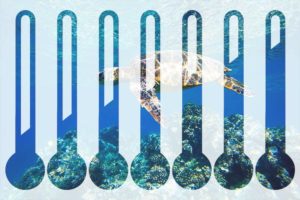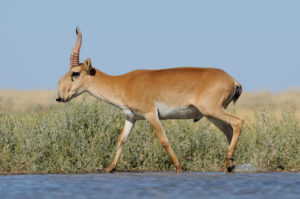Say the words “climate change” in a room full of people and you are bound to inspire some passion in the response—and very likely start an argument. There is no question that emotions and opinions run high whenever this topic is introduced. Most often the debate centers around who or what might be causing changes in the earth’s climate and what should be done about it. So for the sake of everyone’s blood pressure, I want to set some expectations around this blog.
This is not a blog about the causes of climate change. I am not going to talk about who or what might be causing it, nor am I going to discuss ways the changes could be stopped, slowed down or altered.
 The earth’s climate has warmed and cooled before. Looking at ice-core and geological records, we know that the earth has been much warmer than it is now, and we know that it has been much colder. Climate is dynamic, there are always fluctuations in temperature and moisture from year to year and decade to decade. Some of these fluctuations become trends where the changes consistently track in one direction, and some are anomalies, with more extreme climate conditions and less predictable patterns. Plant and animal populations are unquestionably affected by both the year-to-year fluctuations and the long-term trends. In this blog I am going to talk about two rather dramatic examples of the effects climate change. One example looks at the impact of warming global temperatures over time on the breeding populations of green sea turtles. The other is an example of the devastating results of one warm, remarkably humid, spring on the calving aggregations of the saiga antelope.
The earth’s climate has warmed and cooled before. Looking at ice-core and geological records, we know that the earth has been much warmer than it is now, and we know that it has been much colder. Climate is dynamic, there are always fluctuations in temperature and moisture from year to year and decade to decade. Some of these fluctuations become trends where the changes consistently track in one direction, and some are anomalies, with more extreme climate conditions and less predictable patterns. Plant and animal populations are unquestionably affected by both the year-to-year fluctuations and the long-term trends. In this blog I am going to talk about two rather dramatic examples of the effects climate change. One example looks at the impact of warming global temperatures over time on the breeding populations of green sea turtles. The other is an example of the devastating results of one warm, remarkably humid, spring on the calving aggregations of the saiga antelope.
Warming Temperatures and the Feminization of Sea Turtle Populations in the Northern Great Barrier Reef Rookeries
Earlier this month, a report was published discussing the dramatic feminization of certain breeding populations of the endangered green sea turtle along the Great Barrier Reef (1). This study found that the population of green sea turtles originating from the northern Great Barrier Reef nesting beaches had a significant female bias, especially in the juvenile and sub-adult populations (99.1% and 99.8% female, respectively) and even the in the adult population (86.8%). In contrast, turtles originating from the southern nesting beaches showed only a moderate female sex bias (juveniles, 67.8%; sub-adults, 64.5%, and adults, 69.2% female).
You will note that there are no numbers reported on the sex of hatchlings. That is because sea turtles lack external indicators of sex until they reach sexual maturity. Given their endangered status, any interference in the hatchlings mad (and dangerous) rush from their nest to the safety of the sea would be questionable at best. Especially given that currently the only way to accurately sex turtle hatchlings is through a histological examination of their gonads. Juveniles and young adults can be sexed through a combination of laparoscopic examination and hormone measurements. In the open water and at the foraging grounds along the reef the breeding populations (i.e., populations from the northern and southern Great Barrier Reef) mix together. This offers the advantage that you can sample animals from several natal beaches, and because the northern and southern populations are genetically distinct, the samples can be sorted by area of origin.
What could be responsible for such an extreme shift in the sexes of the green sea turtle from the northern Great Barrier Reef? Scientist believe that the answer lies in the turtle’s biology. For all species of turtles, as well as many other reptiles, the incubation temperature during embryonic development determines the sex (2). In sea turtles, cooler incubation temperatures product more male hatchlings, while warmer incubation conditions result in more female hatchlings (1). For the northern Great Barrier Reef, estimates of nesting temperatures (calculated using air and water temperatures), suggest that nests in this region have consistently been above the pivotal temperature of 29.3°C).
It is unclear what the extreme feminization of green sea turtles will do to that population over time, but it is likely that the lack of males will eventually impact the fertility of the females. The life cycle of the endangered green sea turtle is not remarkable any different than that of other sea turtles. After hatching and making their—often harrowing—escape to the sea, sea turtles spend the next several years swimming in the open ocean. The young turtles often range hundreds to thousands of miles from their natal beach before returning to coastal waters and their ancestral foraging areas. Once they reach sexual maturity (~25 years), both males and females have a strong tendency to return to their natal beach to breed, meaning an influx of breeding males from other populations is unlikely.
Natural selection in response to environmental stress takes place over generations, and for long-lived species such as these this often requires a century or more. Without some sort of intervention and management plan, these populations could face a population collapse or outright extinction. In the case of the endangered green sea turtles along the Great Barrier Reef, gradual, long-term climate change in the form of increasing temperatures in their nesting grounds poses a real threat.
A Warm, Humid Climate Anomaly Helped P. multocida Kill Two Hundred Thousand Antelope in Three Weeks

While the green sea turtle is an example of a species negatively affected by long-term climate change, a recent paper in Science Advances describes how another highly endangered species was susceptible to a shorter term climate event (3). In 2015 scientists who had gathered in Kazakhstan to observe calving aggregations of the saiga antelope (Saiga tatarica tatarica) watched in horror as one-by-one the entire aggregation dropped dead.
In just three weeks, 200,000 antelope (~62% of the global population) were dead. Scientist who had gathered to observe the calving event now scrambled to collect samples in hopes of determining the cause of the mass mortality event.
An intensive analysis of blood, tissue and milk samples all pointed to the same cause. Hemorrhagic septicemia—or blood poisoning. Scientist found one bacterium, Pasteurella multocida, throughout the all the samples. P. multocida is known to cause hemorrhagic septicemia, and was the only pathogen present in enough of the samples to be a plausible cause.
Unfortunately, identifying the bacterial culprit was only one piece of the puzzle. P. multocida, exists naturally in the nasal passages of the saiga antelope. What the scientists didn’t have was an explanation for the what or why of how the bacteria became a virulent infection. Because all the animals seemed to fall sick and roughly the same time, and because there were two populations that were geographically separated that fell sick at the same time, they concluded that the bacteria wasn’t passing from animal to animal. Typically there is an additional cause of stress, such as a virus infection, that precipitates a P. multocida outbreak, but there was no evidence of a viral infection in the population involved in the 2015 die off. So what factor triggered the bacteria to spread to the animals’ blood?
To find the answer the scientist went back to two mass mortality events that happened close to thirty years ago, in 1981 and 1988. They looked at environmental factors such as temperature and humidity in the weeks and days leading up to all three mass die offs, and they think they have found another piece to the puzzle. For all three events, there was extremely high humidity. They believe that under the warm, extremely moist conditions, the P. multocida populations explode, allowing them to break into the saiga’s blood stream and cause the septicemia.
Although the saiga antelopes are endangered and face continued threats from poaching, habitat loss and migration disruption, they also have shown a history of being able to recover rapidly from low numbers (4). Unfortunately, and the emerging trend of warmer, more humid springs suggests that the high humidity trigger for P. multocida might occur more frequently. In addition, their life history of mass calving aggregations leave them susceptible to other mechanisms of mass mortality events.
Conclusions
Both of these examples highlight the importance that environmental conditions such as climate have on animal populations. For the green sea turtle the risk is that warming temperature might force the feminization of enough of the population that reproductive success is threatened. The danger that climate change poses to the saiga antelopes is more intermittent (for now). Not every spring brings the unusually humid weather, so the risk of another mass die off caused by the same bacterial pathogen is more difficult to predict.
The feminization of the green sea turtle population of the northern Great Barrier Reef is dramatic, but how many other reptile populations are being affected just as severely, and without our knowledge? Are other populations at risk to sudden deadly outbreaks as a result of increases in temperature and humidity? If the animals aren’t being observed, could these deaths already be occurring unnoticed? Our planet has a dynamic environment. It is a balancing act of complex systems, and as conditions in one system change, others must be affected. What these examples brought home to me was that the danger of climate change can be insidious. Like ripples on the water, the effect can be seen far from the source and in unexpected ways.
References
- Jensen, M. P. et al. (2018) Current Biology 28, 154–159.
- G. et al. (2017) Funct. Ecol. 38, 42–49.
- Kock, R. A. et al. (2017) Science Advances, 4
- Bekenov, A. B. et al. (1998) Mammal Rev. 28, 1–52.
Kelly Grooms
Latest posts by Kelly Grooms (see all)
- Don’t Flush Your Kitty Litter! Toxoplasmosis Is a Growing Threat to Sea Otters and Other Marine Mammals - November 12, 2024
- Tardigrade Proteins Might Solve the Cold Chain Problem for Biologics - October 17, 2024
- Mpox—The Latest Zoonotic Virus Making Headlines - September 12, 2024
